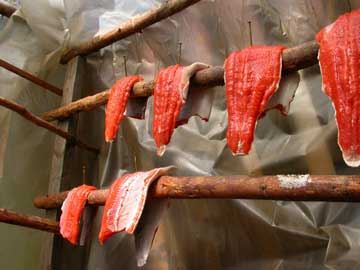|
Alaska's fish are clean, according to
study
May 20, 2004 Alaska - Though buffered by many hundreds of miles from the world's industrial centers, the far north is not as pristine as it seems. Scientists have found dioxins in the breast milk of Native women in Canada's Arctic and pesticide in the bark of Alaska trees, but a new
study shows extremely low levels of toxins in Alaska fish. "It is tremendously good news," said Bob Gerlach, the state veterinarian and Alaska wild food safety coordinator at the Department of Environmental Conservation, the agency that sponsored the study. Gerlach and his colleagues are finishing a study on more than 600 fish samples from the fresh and salt waters across Alaska, from Ketchikan to Norton Sound. The researchers looked at all five species of Pacific salmon from every major drainage in the state, halibut and other bottom-fish, and some freshwater fish, like sheefish and northern pike. Alaska's fish are showing low amounts of PCBs and other organic pollutants that hang around for decades roaming around the planet by hitchhiking in the fat cells of animals. The traces of PCBs and other pollutants can travel north in migrating fish or those fish eaten by Alaska fish. "You're looking at extremely small numbers," said Gerlach, "The only way we'd be happier is if we could find no contaminants, but you'd find traces of these things in every living animal on Earth." PCBs, oily substances once used in the manufacture of electrical equipment, are one example of a manmade pollutant that is slow to break down in the environment. When PCBs escape containment, such as when people dump them in a river, tiny creatures absorb the PCBs, and a fish might eat those tiny creatures. When a person eats the fish, they pick up a dose of PCBs, which researchers have linked to cancer. "These organic contaminants accumulate in fat," Gerlach said. "The older the animal, the more contaminants you find in them." Toxins can also arrive by air. Chemicals released in other parts of the world travel on air currents in warm weather, then fall out with rain or snow as they cool by traveling farther north. After the compounds reach the ground, warm weather can again liberate them into the air, where they continue the journey north. Scientists think that process is responsible for traces of lindane, a pesticide used in large-scale farming, in the bark of trees in Denali Park. "We don't have any factories producing these toxic elements," Gerlach said. "We're kind of innocent bystanders up here." Still, for all the bad stuff in the air and in the fat cells of wandering animals, Alaska seems to be a pretty clean place, as least as far as fish are concerned. "I think from the amount of information we know right now combined with a previous study done by U.S. Fish and Wildlife Service on contaminants in salmon from the Yukon and Kuskokwim, it was tremendously good news for Alaska," Gerlach said. Besides being good news, the DEC study is important for Alaska as a "baseline" measurement with which scientists can compare future levels of toxins in fish from the same waters. Before the study, scientists didn't know how clean a fish caught in a particular area might be. Now, they know that all the fish in their study were almost pollutant-free. This column is provided as a public service
by the Geophysical Institute, University of Alaska Fairbanks, in
cooperation with the UAF research community. Ned Rozell is a science writer at
the institute.
|

